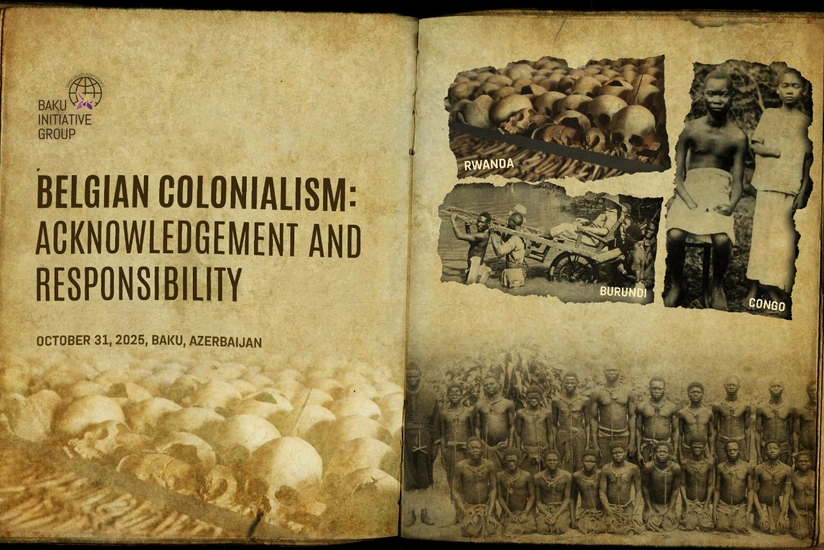|
|
TODAY.AZ / Your Corner
Your Corner: The Bridge of beauty and understanding
08 April 2010 [12:12] - TODAY.AZ
"Your Corner" is exactly what you think it is - your stories, pictures, art, and pretty much everything else you can share with the rest.
 An interesting essay is exactly what we have today for our readers. This was sent to us by our frequent interviewee and reader Rene Wadlow. According to him "The United Nations General Assembly has designated the year 2010 as the "International Year of the Rapprochement of Cultures", and below is one of the essays he writes on this theme, by highlighting persons whose life and works have built cultural bridges.
An interesting essay is exactly what we have today for our readers. This was sent to us by our frequent interviewee and reader Rene Wadlow. According to him "The United Nations General Assembly has designated the year 2010 as the "International Year of the Rapprochement of Cultures", and below is one of the essays he writes on this theme, by highlighting persons whose life and works have built cultural bridges.The United Nations General Assembly in resolution A/RES.62/90 has proclaimed the year 2010 as the International Year for the Rapprochement of Cultures “to promote universal respect for, and observation and protection of, all human rights and fundamental freedoms.” Cultures encompass not only the arts and humanities but also different ways of living together, value systems and traditions.
Thus, 2010 should provide real opportunities for dialogue among cultures. It is true that to an unprecedented degree people are meeting together in congresses, conferences and universities all over the globe. However, in themselves, such meetings are not dialogue and do not necessarily lead to rapprochement of cultures. There is a need to reach a deeper level. Reaching such deeper levels takes patience, tolerance, the ability to take a longer-range view, and creativity. Thus we are pleased to present the creative efforts of individuals who have helped to create bridges of understanding among cultures.
Jalal al-Din Rumi (1207-1273), a poet and mystic of Persian culture, was born in what is today Afghanistan and died in what is now Turkey. He used the image of a person as the flute of the Spirit. Man is a flute for the breath of God — the instrument that the Spirit uses to express itself.
The Spirit can use the flute of any quality. What is important is not the merit of the flute, but the strength of the wind of the Spirit. Thus, Rumi develops the idea of “grace” — the Divine can come to fill the lowest of vessels. The coming of the Spirit, the blending of the individual soul with the Universal Spirit, does not depend on the good actions or piety of the individual. Here Rumi echoes an earlier Sufi writer al Bistani who called upon the aspirant to “Be in the domain where neither good nor evil exists: both of them belong to the world of created things: in the presence of Unity, there is neither command nor prohibition.”
Yet there is a dual motion of the human soul. The first is to wait in silence to be filled with the Spirit coming from without — the image of the flute and breath. The opposite image is that of the soul rising through effort to a higher stage of being. For this motion, Rumi uses the image of a ladder, the steps of the ladder being the stages of development and purification. As he writes in Diwani Shams Tabriz “ A ladder stood whereby thou mightest aspire.” On the ladder, someone else has climbed first and serves as a guide.
For Rumi, this guide was his teacher and friend to whom the verses are dedicated: Shams al-Din of Tabriz. The Diwan contains profound verses on the function of a spiritual master and the relation between master and disciple. The name Shams al Dion means the ‘sun of religion’, and Rumi uses the symbolism of the name which refers to the inner union of the master with God.
Three examples:
“From Tabriz shone the Sun of Truth, and I said to him: Thy light is at once joined with all things and apart from all.”
“The sun of the face of Shamsi Din, glory to the horizons, never shone upon aught perishable but he made it eternal.”
“From the sun, the pride of Tabriz, behold these miracles, for every tree gains beauty by the light of the sun.”
By following the example of the teacher, the pilgrim begins to undergo those experiences which comprise different states and stations. As another Sufi writer Mahmud Shabistari states in The Mystic Rose Garden “As for the saints on this road before and behind, they each give news of their own stages…Since the language of each is according to his degree of progress, they are hard to be understood by the people.”
Little is known of Shams al-Din other than his having been the teacher of Rumi. He seems to have been part of a mystical tradition of Central Asia where influences of Zoroastrianism, Manichaeism and Buddhism from China has been in contact with Islamic thought. The Silk Road from China to the Middle East brought many cultures into contact, and thinkers, especially mystics, were led to see the unity of experience behind the forms of practice.
As Rumi wrote in his best known collection of verses Mathnawi - “ I have given everyone a peculiar form of expression. The idiom of Hindustan is excellent for Hindus; the idiom of Sind is excellent for the people of Sind. I look not at tongue and speech, I look at the spirit and the inward feeling. I look into the heart to see whether it be lowly, though the words uttered be not lowly. Enough of phrases and conceits and metaphors! I want burning, burning: become familiar with that burning! Light up a fire of love in thy soul, burn all thought and expression away!”
“The lamps are different, but the Light is the same: it comes from Beyond. If thou keep looking at the lamp, thou art lost: for thence arises the appearance of number and plurality. Fix thy gaze upon the Light, and thou art delivered from the dualism inherent in the finite body…The Faithful are many, but their Faith is one; their bodies are numerous, but their soul is one.”
Rumi developed a form of combined mobile meditation, symbolism, and teaching which became the basis of the Mevlevi dervishes, popularly called the whirling dervishes and called the Mawlawi dervishes in the Arab countries. The participants enact the turning of the planets around the sun, a symbol of man linked to the center which is God, source of life, but it is also an internalized turning of the body toward the soul, likewise source of life. Rumi tried to map out a system in which sound, motion and one-pointed concentration of thought would lead to an end to the personal self and union with the Higher Self.
There is a danger that the remaining Mevlevi dervishes become folklore in Turkey with attention paid primarily to the external music and motion, but we may help highlight the deeper meanings.
Rene Wadlow
Representative to the United Nations, Geneva
Association of World Citizens
Don’t forget that you also have an opportunity to share something of your own with us, and the rest of the readers. Whether it’s an interesting episode of your everyday life, some sort of art, glamorous photos, videos, bizarre – weird – breaking news, interesting interviews, your own written science fiction tale, a sad love story or even a poem – share with the rest & let yourself be known.
Editorial board reserves the right to publish your sent material, or skip it, based on our policies. When sending your material, please choose one of the following: real life stories, own written story (fiction), photo-video, other. Also, please provide the full name we should credit the material for, and a short description of the material itself.
All of the materials are to be sent here: [email protected]
Send them out, “Your Corner” is waiting!
/Today.Az/
URL: http://www.today.az/news/yourcornenr/65716.html
 Print version
Print version
Views: 19737
Connect with us. Get latest news and updates.
See Also
- 14 September 2025 [23:23]
Trump backs sanctions if NATO stops buying Russian oil - 31 March 2025 [21:45]
DeepSeek, "Ne Zha 2" offer glimpse into China's high-quality growth - 16 May 2024 [22:19]
Turkish Defense industry achieves self-sufficiency in military cable production - 16 May 2024 [21:50]
Russia and China expand cooperation in the energy sector - 07 January 2024 [20:40]
China plans to invest more than $11bn in development of Tibet in 2024 - 03 January 2024 [18:05]
Azerbaijani hero: One-man army destroying Armenian myth - 18 November 2023 [10:00]
Another group of IDPs return to Zabukh village [PHOTOS] - 05 November 2023 [10:28]
German FM is either lying or trying to cover up some dirty agenda - 05 November 2023 [10:00]
Azerbaijan and Germany enjoy huge potential for cooperation in many areas - 21 October 2023 [23:57]
Co-operation between Azerbaijan and Kazakhstan in various directions discussed
Most Popular
 Road exchange and its subtleties for Baku and Yerevan
Road exchange and its subtleties for Baku and Yerevan
 Crime without statute of limitations: five years since tragedy of Barda
Crime without statute of limitations: five years since tragedy of Barda
 Pakistan closes airspace along border amid India’s large-scale military drills
Pakistan closes airspace along border amid India’s large-scale military drills
 Azerbaijani Foreign Minister meets Omani counterpart to boost bilateral cooperation
Azerbaijani Foreign Minister meets Omani counterpart to boost bilateral cooperation
 World Bank urges Azerbaijan to accelerate reforms to attract private investment
World Bank urges Azerbaijan to accelerate reforms to attract private investment
 Azerbaijan, Oman discuss deepening partnership during official talks
Azerbaijan, Oman discuss deepening partnership during official talks
 BIG to host first international conference on Belgian colonialism
BIG to host first international conference on Belgian colonialism
